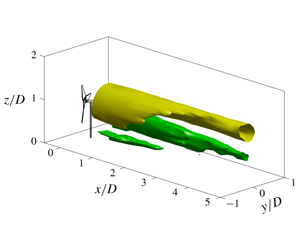Article contents
A point vortex transportation model for yawed wind turbine wakes
Published online by Cambridge University Press: 11 March 2020
Abstract

In this study, stereo particle imaging velocimetry measurements are performed at multiple streamwise locations behind a yawed wind turbine to reveal the formation mechanisms of the counter-rotating vortex pair (CVP), and a point vortex transportation (PVT) model is proposed to reproduce the top–down asymmetric kidney-shaped wake (also referred to as a curled wake). Results indicate that the CVP formed behind a yawed wind turbine originates from the complex interactions between the hub vortex and the streamwise components of the blade tip vortices, which is fundamentally different from the case of a yawed drag disk where the hub vortex is absent. Specifically, when the yaw angle exceeds a critical value, a small part of the streamwise vorticity shed from the rotor disk edge switches its sign from negative to positive and subsequently merges with the concentrated hub vortex under mutual induction, creating a patch of positive vorticity; meanwhile, the remaining streamwise vorticity distributed along the rotor edge curls and evolves into another patch of negative vorticity. These two patches of streamwise vorticity essentially constitute the CVP. Based on the physics learnt from the experiments, the non-uniform cross-stream velocity fields are first reconstructed by a cloud of point vortices distributed along the rotor edge and a hub vortex located in the rotor centre, and subsequently used to numerically solve a simplified transportation–diffusion equation of the wake velocity deficit, which altogether constitute the PVT model. This physics-based reduced-order model is the first model capable of accurately reproducing the wake deformation behind a yawed wind turbine.
- Type
- JFM Papers
- Information
- Copyright
- © The Author(s), 2020. Published by Cambridge University Press
References
Zong and Porté-Agel supplementary movie 1
Evolution of the cross-stream velocity and vorticity fields simulated by the PVT model at a yaw angle of 0 degrees
Zong and Porté-Agel supplementary movie 2
Evolution of the cross-stream velocity and vorticity fields simulated by the PVT model at a yaw angle of -10 degrees
Zong and Porté-Agel supplementary movie 3
Evolution of the cross-stream velocity and vorticity fields simulated by the PVT model at a yaw angle of -20 degrees
- 36
- Cited by


